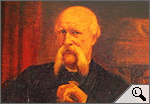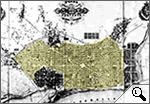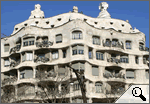|
|
|
 |
 |
 > Ildefons Cerdą and the Barcelona of the mid-19th century > The Cerdą Plan > Modernist designs dimarts, 2 de juny de 2009
This Sunday, 7 June, will be the 150th anniversary of the Reform Plan ('Pla de Reforma') and of the Eixample in Barcelona, designed by the engineer, urban planner and politician Ildefons Cerdą. The result of the 'Cerdą Plan', as it is known, was the Eixample, a leading example throughout the world of modern urban planning.
To mark the anniversary, Barcelona has organised Cerdą Year, which will run for 12 months, until June next year. Amongst other events, the programme includes exhibitions, conferences, city tours and an education project. Although the official opening of Cerdą Year is not until 11 June, visitors have been able to see the 'Practical politics. Cerdą and Barcelona Provincial Council' exhibition for a few weeks already. The exhibition looks at the political and ideological side of Ildefons Cerdą. This aspect of Cerdą is more important than it might appear. His progressive, advanced ideas were reflected on his Eixample plan, something that turned him into an object of criticism. Well, that and the fact that the plan had been imposed by the government of Madrid (seen in Catalonia as an act of Spanish centralism): the design competition held by Barcelona City Council had been won by the architect Antoni Rovira Trias, and not by Cerdą.
Ildefons Cerdą and the Barcelona of the mid-19th centuryBarcelona experienced a period of major transformation in the middle of the 19th century. As a result of industrialisation, the population was increasing relentlessly, packed into the narrow streets within the city's walls in somewhat unhygienic conditions. There was an urgency, therefore, to adapt the urban area to new needs. Ildefons Cerdą thought he knew what these needs were and he presented his response to them in an innovative, rationalistic and practical plan.
The Cerdą PlanCerdą based his urban plan on an orthogonal design. The centre of the plot was a block that combined houses and green spaces, fusing city and nature. The idea was for the block to be built on two sides only, leaving the interior area for allotments and gardens. Unfortunately, urban speculation and the desire to make money distorted Cerdą's plan: the buildings were much higher than those initially planned and even the interior areas of the blocks were used for buildings. However, such abuses to the radically original plan did not cancel out its merit.
Modernist designsGradually, bourgeois Catalans who had made themselves rich through trade and industry, competed to fill the Eixample with ever-more beautiful and original houses. The design of these houses was entrusted to the most famous architects of the time: Antoni Gaudķ, Lluķs Domčnech Montaner and Josep Puig Cadafalch. The result, jewels of Modernist art, were houses such as Amatller, Batlló, Fuster, Lleó Morera, Milą (known as 'la Pedrera'), and Punxes.
|
Investiga

> Vķdeo de l'exposició 'La polķtica prąctica. Cerdą i la Diputació de Barcelona'.

> L'Eixample a vol d'ocell.

> El pla Rovira Trias: l'alternativa frustrada.

> La dreta de l'Eixample, a l'ombra del modernisme.
I també...
- Catalunya a mitjan segle XIX: les transformacions urbanes.
- 'Ildefons Cerdą i l'Eixample de Barcelona'.
- Ruta modernista per Barcelona.
Portada |
Europa Press |
El Punt |
La premsa |
Especials |
Diari de l'escola |
LesFinances.info |
Editorials |
Mail obert |
Els blocs |
Lletres
Tecnologia i cičncia | Solidaritat | Cap de 7mana | Campus | El 9 | Presčncia | Fņrums | Enquestes | Xat | Correu
Traductor | Edicions en Pdf | Wap-pda | Biblioteca | Lletra més grossa
Tecnologia i cičncia | Solidaritat | Cap de 7mana | Campus | El 9 | Presčncia | Fņrums | Enquestes | Xat | Correu
Traductor | Edicions en Pdf | Wap-pda | Biblioteca | Lletra més grossa
| Quč és VilaWeb? Publicitat Mapa web Contacte | Una web de Partal, Maresma i Associats, S.L. |




